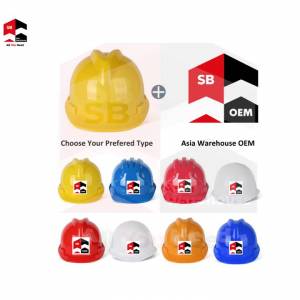Showing all 3 results
Best Safety Helmet Supplier in Malaysia
Asia Warehouse has established a strong reputation for providing high-quality safety helmets in Malaysia that meet industry standards and regulations. With a wide range of options, we offer reliable head protection products designed for various industries, such as construction, manufacturing, and oil and gas.
Frequently Asked Questions on Safety Helmet Malaysia
What is a safety helmet, and what are its uses?
A safety helmet, also known as a hard hat, is a piece of protective gear worn on the head to protect against impact, falling objects, flying objects, debris, and electrical hazards. It is a crucial personal protective equipment (PPE) in many workplaces and activities.
What are the three classes of hard hats?
The specific classes of safety helmets can vary depending on regional regulations and industry standards. However, here are some general categories:
- Class E (Electrical): These helmets provide electrical insulation to protect against electrical shocks and burns. They are commonly used in industries where workers may be exposed to electrical hazards.
- Class G (General): Helmets in this class are designed to protect against impact and penetration hazards. They are suitable for general industrial use with a risk of falling objects and other head injuries.
- Class C (Conductive): Helmets in this class offer no electrical protection and are not intended for use when electrical hazards are present. They provide fundamental impact and penetration protection and are often used in construction and manufacturing.
What are the two main types of industrial safety helmets?
The two main types of industrial safety helmets are Type I and Type II.
- Type I: Helmets designed to provide top impact protection. They protect against blows to the top of the head. They are commonly used in construction and industrial settings.
- Type II: Helmets designed to provide both top and lateral impact protection. They offer additional protection against impacts from the sides or off-centre, making them suitable for a broader range of applications.
What does the colour code of safety helmets mean?
The colour coding of safety helmets is often used to convey specific information about the role or status of individuals within a workplace. It can vary between different industries and regions.
- White: Often worn by managers, engineers, supervisors, or inspectors.
- Yellow: Commonly used by general labourers, construction workers, and ground crew.
- Blue: Can signify carpenters, electricians, technical operators, or visitors (depending on region).
- Green: Often associated with safety inspectors, new workers, or probationary personnel.
- Orange: Typically worn by crane operators, slingers, signallers, or road crews.
- Red: May identify fire marshals, welders, or personnel in high-heat areas.
- Brown: Sometimes used by welders or personnel working with high temperatures.
- Grey: Occasionally worn by site visitors (varies by region).
When should I wear a safety helmet?
Safety helmets should be worn in various work environments where there is a risk of head injuries due to falling objects, impact from low ceilings or protruding structures, or exposure to electrical hazards. Specific situations and industries where wearing a safety helmet is typically necessary include construction sites, manufacturing facilities, industrial settings, mining operations, and areas where heavy machinery or equipment is used.
How to check the safety helmet expiry date?
Safety helmets typically do not have a specified expiration date, but they have a recommended service life, often indicated by the manufacturer. It is essential to check for any manufacturing date or “date of manufacture” on the helmet, which is usually imprinted on the inside. The service life is influenced by factors such as exposure to sunlight, temperature variations, and the specific conditions of use.



